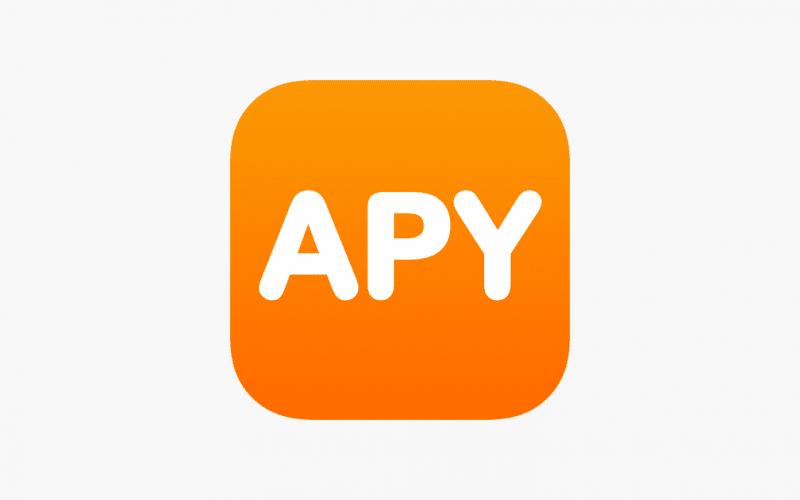It’s possible to multiply your initial investment using a variety of strategies. To some people, investing in the stock market may seem like a good idea, but it’s not the best choice for everyone. Some people would rather play it safe by putting their money in deposit accounts that provide an annual percentage yield (APY). The yearly interest earned on a savings or checking account is expressed as an annual percentage yield (APY), which is a percentage based on the interest rate and the frequency with which interest is compounded. The annual percentage yield formula (APY) is a useful tool for financial forecasting, especially over longer time horizons. We will discuss APY banking, how to calculate it, and the difference between APY and APR in this article.
What is APY?
An annual percentage yield (APY) is a measure of the effective rate of return on a bank account over the course of a year. The frequency of interest payments and the impact of compounding interest are put in to generate a more precise prediction of returns. This involves keeping track of how interest accumulates on the principal and how the rate of return rises over time, assuming no withdrawals are made.
Furthermore, Interest rates are a way to quantify the value of a financial investment over a given time period, and simple interest accounts reward investors by adding no more funds to their balances. Accounts with compound interest, on the other hand, accelerate over time by accruing interest on both the principle and the interest. Thus, the interest earned on a 1% deposit that compounds once a year is less than the interest earned on a 1% deposit that compounds once per month. APY accounts for this factor.
What the Annual Percentage Yield Tells You
In the end, the rate of return on investment is what matters most, regardless of whether the investment in question is a certificate of deposit (CD), a piece of stock, or a government bond. The rate of return on investment is simply the percentage of growth in the value of the investment over a predetermined amount of time, most commonly one year. However, if various assets have different compounding periods, it might be challenging to compare the rates of return offered by each of these investments. One person might compound their meals once per day, while another would do it four or six times each year.
When comparing rates of return, it is not possible to arrive at a realistic conclusion by merely expressing the percentage value of each over one year because this approach overlooks the impacts of compounding interest. Since the rate of return on investment is proportional to compounding frequency, it is crucial to know it. This is because each time it compounds, the interest generated during that period is added to the principal balance, and subsequent interest payments are computed based on that bigger main amount. As a result, this results in a higher total amount of interest paid over time.
Do Annual Percentage Yields (APY) Change?
Depending on the kind of deposit account, the yearly percentage yield (APY) may be flexible. The annual percentage yield (APY) on a savings or money market account might fluctuate. This indicates that it is pegged to a primary rate of interest.
Your annual percentage yield (APY) may go up or down depending on whether the benchmark rate goes up or down. The interest rate on savings accounts often shifts in tandem with changes in the federal funds rate. Banks may cut the APY offered to savers if the Federal Reserve reduces interest rates.
The annual percentage yield (APY) you receive on CDs is often unchanging. A certificate of deposit (CD) is a type of time deposit in which the depositor commits to leaving their money in the account for a certain time frame. In return, you lock in a predetermined rate of interest on your CD’s principal until its maturity.
If you choose to roll over your CD when it matures, the interest rate you receive could go up or down depending on the benchmark rate. This generalization has a few caveats, though. Although it is not the norm for standard CD accounts, some banks do offer raise-your-rate CDs or bump-up CDs that allow you to boost your rate and APY during your CD term.
What Is APY in Crypto?
One thing can be very useful if you are a beginner investor trying to predict returns on your crypto funds. To anticipate your future earnings and put into practice a workable passive income approach, open an APY (Annual Percentage Yield) account.
When calculating compound returns each year, the Annual Percentage Yield is a helpful tool. You’ll need these two numbers to do the math:
- The whole sum invested;
- Duration of an investment strategy.
For this reason, annual percentage yield (APY) can be viewed as a time-bound return on investment (ROI).
To put it simply, it’s a way to invest in Bitcoin or any other cryptocurrency and receive a guaranteed return at the end of a set period of time. Investing $10,000 USDC at 10% APY will net you $11,100 after one year. Interest might accrue on a daily, weekly, monthly, or other timetables. Interest earned on a savings or checking account can be withdrawn at any time, or it can be allowed to collect to boost the annual percentage yield (APY).
Staking, DeFi lending, and crypto savings accounts are the most prevalent ways to passively generate APY on crypto assets.
How Does Apy Calculate?
To calculate APY, you’ll need to use this formula:
APY = (1 + r/n)” – 1
r= period rate
n= number of compounding periods
You won’t have to do the math on your own to determine the APY of a savings, money market, or certificate of deposit account because most banks will proudly display the APY on their websites.
This is just an example of how annual percentage yield is calculated, but it’s available if you’d like some exercise. Let’s pretend you’re weighing your options for a savings account with a 0.06% yearly interest rate that accumulates monthly (12 times per year).
This is how we would calculate the APY on this savings account: APY = (1+0.0006/12)12 -1. Always keep in mind that a 0.6 percent interest rate, when written out in decimal form, is.0006. Interest on this account is compounded twelve times a year, hence the “12” in the equation.
If you plug these figures into a formula, you get an annual percentage yield of 0.060017%.
You may calculate your potential profit for a year using the APY. However, you’ll need a new formula that factors in your account’s principal balance to achieve this.
A simple formula for calculating earnings at a certain APY is (APY x principal) + principal = total earnings after a year.
How Does Annual Percentage Yield (APY) Work?
An interest-bearing account is one that earns interest on the money deposited into it, such as a savings account, money market account, certificate of deposit (CD), and some checking accounts.
Interest earnings on a savings or investment account can be calculated with the help of a technique called annual percentage yield, which takes into account both the interest rate on the account and the frequency with which interest multiplies.
When deciding on a savings account or other investment vehicle, it’s important to consider how often interest is compounded. Each year, more money can be made using accounts that pay interest more frequently than those that do not.
There is never any requirement for a bank to pay interest. There are four possible choices, but most people choose one of the first two.
Annual compounding of interest is a feature of some accounts. As a result, interest is calculated and disbursed annually. Interest on some accounts is compounded quarterly, while on others it is calculated and paid every three months.
Interest on monthly compounding accounts is calculated and disbursed monthly. Financial institutions that compute and distribute interest on a daily basis are said to compound interest daily.
To put it another way, APY is crucial because of this. If one account’s interest rate is higher than another’s, then naturally the former will provide higher returns. Perhaps if interest was compounded more frequently, the second account could pay out more over the course of the year.
If you’re shopping around for a new savings account, money market account, checking account, CD, or another investment vehicle, it’s important to look at the annual percentage yield (APY) as well as the interest rate.
Apy vs Apr
The primary difference between APY and APR is that the former factors in compound interest while the latter does not. Investment transaction fees and other charges are also included in the APR calculation. Simply said, the annual percentage rate (APR) is the sum of the interest paid plus any fees added to that interest.
When it comes to actual use, there is one key difference between APY and APR. When calculating interest, APY will always result in a higher rate than when using just the simple interest rate (a bigger number). Since this is the case, it is generally more appealing when the financial instrument in question refers to a means by which one can increase their wealth, such as interest on a bank savings account. In contrast, the annual percentage rate (APR) is utilized for outgoings that will cost consumers money, such as credit card and mortgage interest rates, because it is lower.
Substituting the yield per year for the APR gives the true rate. Consider a credit card that offers a 1.5% interest rate per month, or an 18% annual percentage rate (APR). The APR you’ll pay after a year of making monthly credit card payments with debt is 19.56%. Also, read WHAT IS APR: How it works.
Is APY Crypto Interest?
In both traditional banking and the crypto industry, APY refers to the yearly percentage yield on an investment. Because of compound interest, the annual percentage yield (APY) is employed to calculate investment returns instead of the interest rate.
What Is the Highest Apy in Cryptocurrency?
The annual percentage yield (APY) on Cosmos is the highest available at 5%, while the yield on Ethereum is 4%. Ezos and Algorand have transaction fees of 4.64% and 4%, respectively, whereas Dai and USDC have 2% and 0.15%.
Apy Banking
A variety of yielding APY banking products are available.
- savings accounts that provide interest
- Accounts that have been around for a long time
- Accounts that offer high returns on savings
- Accounts for the short-term purchase of government securities
- Money market instruments;
- CDs
The annual percentage yield (APY) you can earn with a credit union, internet bank, or brick-and-mortar bank will vary. You can quickly calculate the potential growth of your money over a year by looking at the annual percentage yield.
A greater annual percentage yield (APY) on an interest-bearing account is preferable. APY, fees, minimum deposits, and other criteria matter when choosing a saving, money market, or another interest-bearing account.
Is APY Calculated Monthly?
No, APY is not calculated monthly. It is the change in money over a year.
Conclusion
Understanding the APY is crucial to make the most of your savings bank accounts. Also, think about how often the APY is compounded; a difference between daily, monthly, quarterly, and yearly compounding can really add up. It’s easy to feel like your funds aren’t growing when interest rates are low nationally. When rates are low, it’s especially important to achieve a high annual percentage yield (APY) on your savings.
APY FAQs
What is a good APY?
You can find savings rates that are higher than the national average of 0.33% APY. Online savings accounts typically offer rates of 2.00% or more, making them a top choice for many savers.
Is APR or APY better?
In contrast to the annual percentage rate (APR), the annual percentage yield (APY) represents the rate of return on savings. Borrowers benefit more from a low APR, while savers see greater returns from a higher APY.
Does Binance have APY?
As of recently, Binance customers can earn up to 10% APY on their BUSD and USDT Flexible Savings thanks to an increase in the APY.
Similar Posts
- THE ANNUAL PERCENTAGE YIELD: How It Works With Your Savings Account.
- What Are SHORT-TERM INVESTMENTS: Definition, Examples, and Banks
- BUSINESS DEPOSIT ACCOUNTS: List of the Best Deposit Accounts in 2023.
- SHARE CERTIFICATE: Overview, Templates, Rates, Formats(+Quick Tool).






